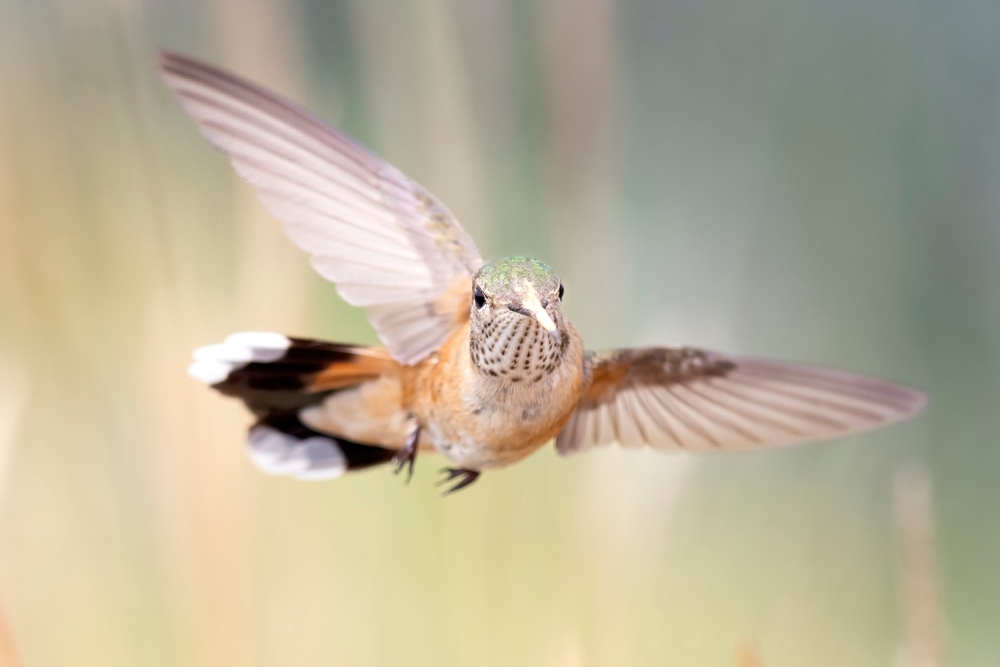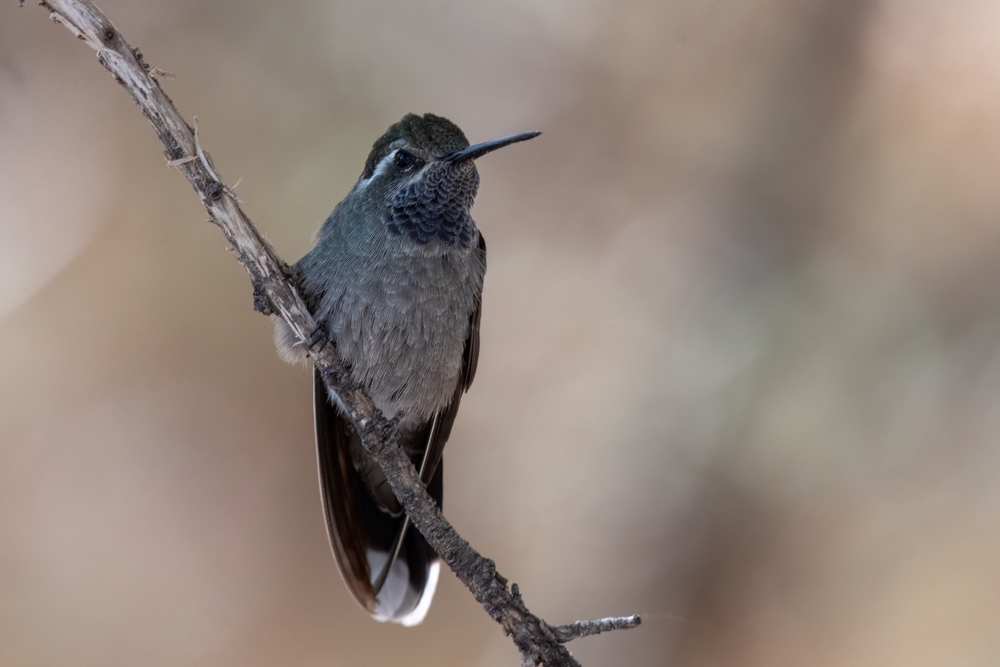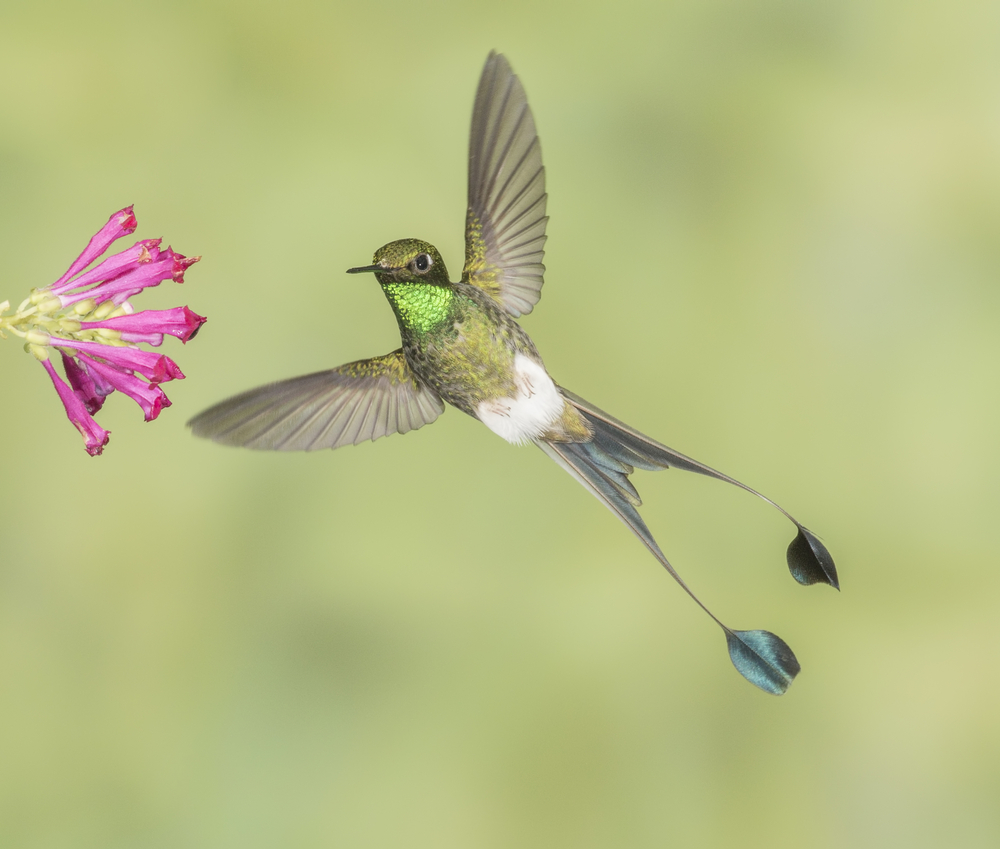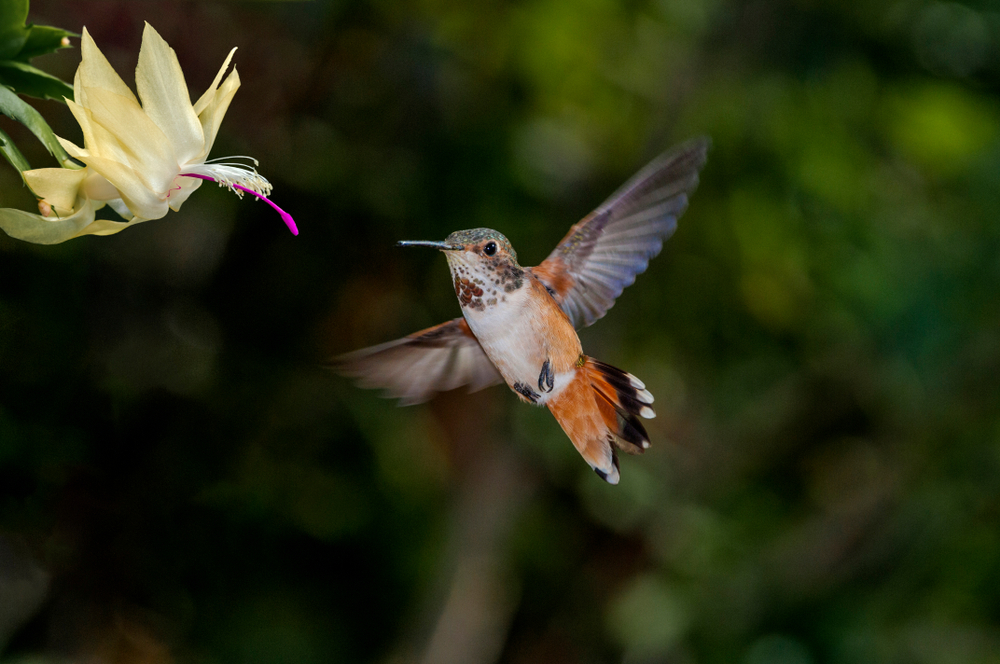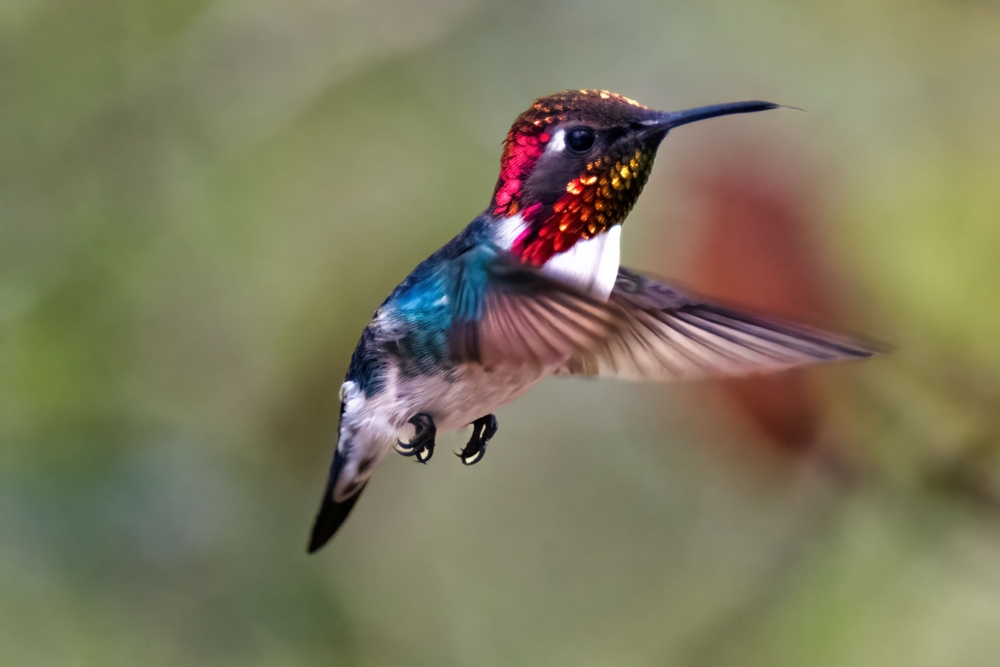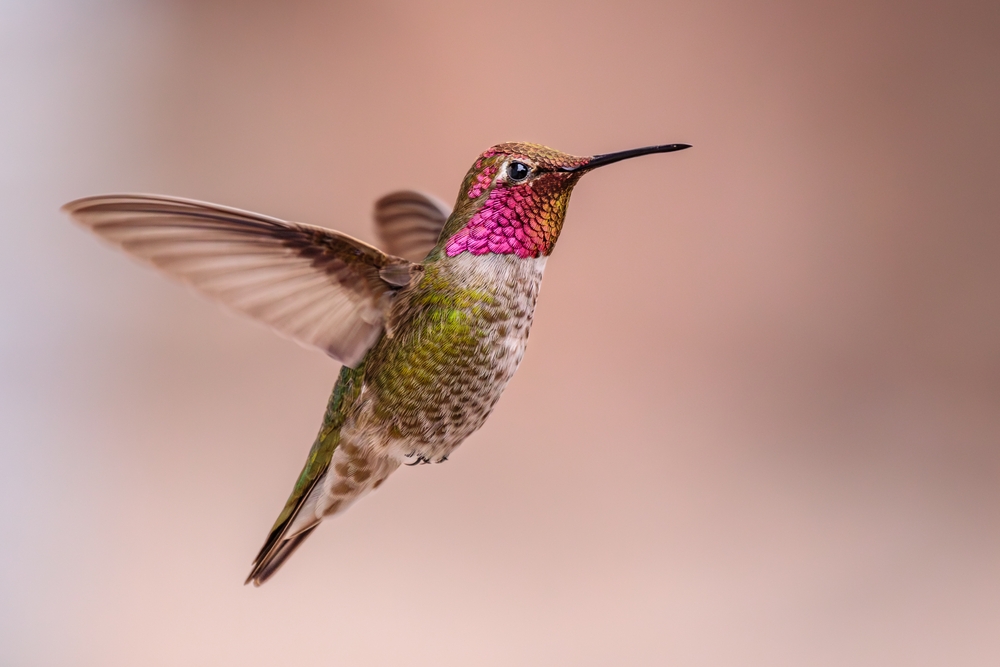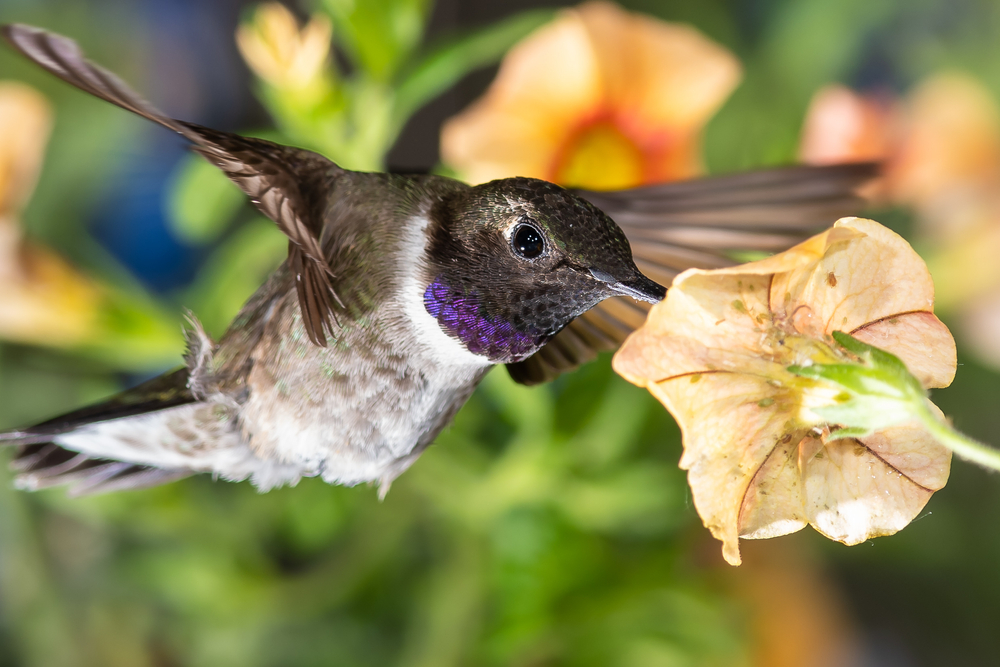The Broad-tailed Hummingbird (Selasphorus platycercus) is most closely related to other Selasphorus hummingbirds, especially the Rufous Hummingbird (Selasphorus rufus) and Allen’s Hummingbird (Selasphorus sasin), which share similar size, structure, and iridescent gorgets.
About
The Broad-tailed Hummingbird (Selasphorus platycercus) is a medium-sized hummingbird of the family Trochilidae, found throughout the western United States, Mexico, and Central America. It is a species closely tied to mountain meadows, open woodlands, and high-altitude habitats, often nesting at elevations up to 10,500 feet (3,200 m). During the summer months, it is especially common in the Rocky Mountains, where its distinctive metallic trills fill alpine valleys.
Measuring about 9–10 cm (3.5–4 in) in length and weighing 3–4 grams, the Broad-tailed Hummingbird is modest in size but striking in color. Males display a brilliant rose-red throat (gorget) that flashes in sunlight, contrasted with iridescent green upperparts and a white chest. Females and immatures are less vibrant, with green backs and pale underparts speckled with buff and green. Both sexes are named for their relatively broad tail feathers, which produce a noticeable whistling or trilling sound during flight, particularly in males.
This species feeds on nectar from a wide variety of alpine and meadow flowers, making it an important pollinator in high-elevation ecosystems. Insects and spiders are also eaten for protein, especially during the breeding season when females must nourish chicks.
Breeding occurs in spring and summer. Males perform dramatic aerial displays, rising high and diving steeply while producing buzzing wing sounds to impress females. After mating, the female alone builds the nest, a tiny cup of plant fibers, spider silk, and lichen, usually placed on tree branches or shrubs. She lays two small white eggs and raises the young independently.
The Broad-tailed Hummingbird is migratory, traveling south to spend winters in Mexico and Central America before returning to the mountains of the western U.S. Its adaptation to cold, high-altitude environments and reliance on alpine blooms make it a fascinating example of ecological specialization.
Physical Characteristics
Plumage:
The Broad-tailed Hummingbird (Selasphorus platycercus) is a medium-sized, colorful hummingbird of the western mountains.
-
Male: Metallic green upperparts, whitish underparts with buffy sides, and a dazzling rose-magenta gorget (throat patch) that flashes brilliantly in sunlight. The tail is relatively broad, cinnamon-rufous in color, and edged with green.
-
Female: More subdued, with green upperparts, pale underparts spotted on the throat, and a rufous-washed tail with white tips. Females lack the brilliant gorget of males.
Head:
The male’s gorget is iridescent and angle-dependent, appearing dark in shade but glowing pink in light. Both sexes have a straight, slender, black bill adapted for nectar feeding.
Body:
Compact, streamlined, and slightly larger-bodied than some other North American hummingbirds. Females appear greener overall, while males stand out with their shimmering gorget and rufous tail.
Size:
-
Length: 3.25–4 in (8–10 cm)
-
Wingspan: About 5.25 in (13–14 cm)
-
Weight: 0.1–0.2 oz (2.8–4.5 g)
Feet & Tail:
Tiny feet are used mainly for perching. The broad, rufous-colored tail is distinctive and fans out noticeably in flight, producing a characteristic whirring sound in males.
Flight Style:
Wingbeats average 50–55 per second, with males producing a trilling wing sound during flight displays, caused by air rushing over the outer primaries. They are agile fliers, capable of hovering, flying backward, and executing swift aerial dives during courtship.
The Broad-tailed Hummingbird’s brilliant gorget, broad rufous tail, and trilling wingbeats make it one of the most distinctive hummingbirds of the Rocky Mountains and western highlands.
Reproduction
Breeding Season:
Broad-tailed Hummingbirds breed in the spring and summer months (generally May through July) across their high-elevation range in the Rocky Mountains and western U.S., timed with peak wildflower blooms.
Courtship:
-
Males perform dramatic aerial display dives, rising high into the air and then diving steeply past a female, producing a loud trilling sound with their wings (caused by specialized primary feathers).
-
Males also hover in front of females, flashing their rose-magenta gorget in direct sunlight.
-
As with most hummingbirds, males take no part in nesting or chick care.
Nesting:
-
The female alone builds the nest, usually on a horizontal tree branch, sheltered in pine, aspen, or oak woodlands.
-
Nests are tiny and cup-shaped, about 1.5 in (4 cm) across, made of plant down, moss, and spider silk, camouflaged with lichens.
-
The flexible design allows the nest to expand as chicks grow.
Eggs:
-
A clutch typically contains 2 tiny white eggs, each about the size of a pea (0.5 in / 1.3 cm long).
Incubation:
-
Lasts 16 to 19 days.
-
Only the female incubates the eggs.
Chick Development:
-
Hatchlings are altricial (blind and featherless at birth).
-
The female feeds them a mixture of regurgitated nectar and small insects.
-
Nestlings fledge at about 20 to 23 days, but may remain dependent on the female for another week or two.
Maturity:
-
Juveniles begin independent foraging soon after fledging.
-
Sexual maturity is reached at about 1 year of age, when they are capable of breeding.
The Broad-tailed Hummingbird’s reproduction is notable for its male’s trilling wing displays and the female’s delicate nest construction high in mountain woodlands.
Lifespan
In the Wild:
Broad-tailed Hummingbirds typically live 3 to 5 years in their mountainous habitats. Like most hummingbirds, the majority do not survive their first year due to predators, harsh weather, or migration challenges. Adults that establish territories and foraging routes often live longer.
In Captivity:
Though rarely kept, individuals in rehabilitation or conservation care may live a little longer, sometimes reaching 7 to 8 years with reliable food and no predators.
Record Lifespan:
The oldest recorded wild Broad-tailed Hummingbird, documented through banding studies, lived at least 12 years, an exceptional age for such a small bird.
Threats to Longevity:
-
Predation: By hawks, jays, snakes, and domestic cats.
-
Migration Risks: As long-distance migrants, they face storms, exhaustion, and lack of food along migratory routes to and from Mexico and Central America.
-
Climate Change: Shifting bloom times of wildflowers in mountain habitats can disrupt the synchronization of breeding and food availability.
-
Collisions: Window strikes and entanglement in spider webs or human-made materials are common hazards.
The Broad-tailed Hummingbird’s lifespan is short on average, but its resilience, agility, and high-altitude adaptationsallow some individuals to live remarkably long lives for such tiny creatures.
Eating Habits
Diet:
The Broad-tailed Hummingbird is primarily a nectar feeder, but supplements with protein-rich insects. Its diet includes:
-
Nectar: From wildflowers such as larkspur, columbine, penstemon, and Indian paintbrush, as well as cultivated garden flowers.
-
Insects & Spiders: Tiny flies, gnats, aphids, beetles, and spiders, providing essential protein for growth and chick development.
-
Sap: Occasionally visits sapsucker wells to feed on tree sap and trapped insects.
Foraging Behavior:
-
Hovers in front of flowers, extending its long, forked tongue to lap nectar at a rate of up to 13 licks per second.
-
Also perches on branches or feeders when available, often returning repeatedly to the same flowers in a predictable trapline foraging pattern.
-
Catches insects midair (hawking) or gleans them from foliage and spider webs.
-
Males are highly territorial, defending flower patches and feeders aggressively, while females often forage more widely when nesting.
Feeding Adaptations:
-
Long, slender bill suited for tubular flowers.
-
Rapid wingbeats (50–55 per second) enable precise hovering at blooms.
-
Can enter torpor at night to conserve energy when temperatures drop in high-elevation habitats.
Role in Ecosystem:
As an important pollinator in western mountain ecosystems, the Broad-tailed Hummingbird ensures reproduction of many alpine and subalpine wildflowers. By also feeding on insects, it helps control populations of small arthropods.
The Broad-tailed Hummingbird’s nectar specialization, trapline feeding, and territorial behavior make it both an efficient pollinator and a competitive presence in mountain meadows.
Uniqueness
Trilling Wingbeats:
Males produce a loud trilling or whirring sound with their wings during flight, especially in courtship dives. This noise is created by air rushing over modified primary feathers and is one of their most recognizable traits.
High-Elevation Specialist:
Unlike many hummingbirds, Broad-tailed Hummingbirds thrive at high altitudes (up to 10,500 ft / 3,200 m) in the Rocky Mountains and western U.S., perfectly adapted to cold nights and alpine meadows.
Early Migrants:
They arrive on breeding grounds earlier than many hummingbirds, often as soon as mountain wildflowers begin to bloom in spring, ensuring access to nectar.
Trapline Foragers:
Females often follow a trapline feeding strategy, visiting flowers in a repeated sequence rather than defending territories. This contrasts with males, who aggressively guard flower patches.
Longevity Among Hummingbirds:
While small-bodied, some Broad-tailed Hummingbirds live over a decade, one of the longest lifespans recorded for hummingbirds, showing resilience despite migration and high-elevation challenges.
The Broad-tailed Hummingbird’s wing-produced trill, mountain specialization, and remarkable longevity make it one of the most unique and fascinating hummingbirds of the western highlands.
Be the First to Share Photos of This Species.
FAQ’s
1. What is the closest species to the Broad-tailed Hummingbird?
2. How does the Broad-tailed Hummingbird compare to other hummingbirds?
Compared to many hummingbirds, the Broad-tailed is well-adapted to high altitudes, tolerating cold nights by entering torpor. Males are also unique for producing a distinct trilling wing sound, unlike the buzzing or whirring of other species.
3. What national parks provide the best opportunities to see a Broad-tailed Hummingbird?
They are best seen in western U.S. mountain parks, including Rocky Mountain National Park (Colorado), Grand Teton National Park (Wyoming), and Great Basin National Park (Nevada), where alpine meadows and flowering slopes attract breeding populations.



































































